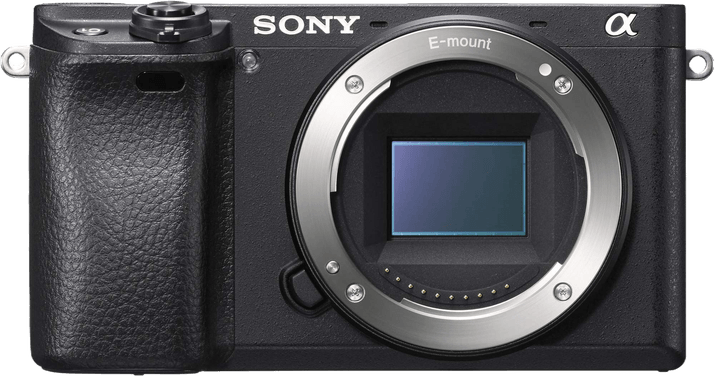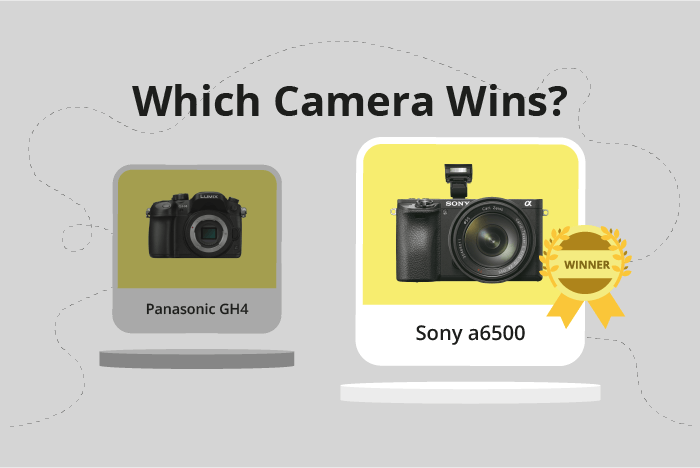Panasonic Lumix DMC-GH4 vs Sony a6500 Comparison
Panasonic Lumix DMC-GH4

Sony a6500

The Sony a6500 emerges as the winner with a score of 72/100, while the Panasonic Lumix DMC-GH4 scores 58/100. Both cameras are mirrorless and were released within two years of each other, with the GH4 in 2014 and the a6500 in 2016. They share common specifications such as camera type and launch prices of $1700 and $1400, respectively.
The Sony a6500 outperforms the GH4 with its smaller size (120 x 67 x 53mm) and lighter weight (453g), making it more portable and user-friendly. However, the GH4 has its advantages with a larger body (133 x 93 x 84mm) and heavier weight (560g), which can provide better stability for certain users.
Considering the specifications, the Sony a6500 is the better camera due to its higher score, smaller size, and lighter weight. The Panasonic Lumix DMC-GH4, while not as highly ranked, still offers benefits in terms of stability with its larger size and heavier weight.
Panasonic Lumix DMC-GH4 vs Sony a6500 Overview and Optics
The Sony a6500 triumphs over the Panasonic Lumix DMC-GH4 in optics with a score of 74/100 compared to the GH4’s 52/100. Both cameras feature a CMOS sensor and offer similar shooting speeds, with the GH4 at 12 and the a6500 at 11. Additionally, they each have different lens mounts, with the GH4 using a Micro 4/3 mount and the a6500 using a Sony E mount.
The a6500 takes the lead with its 24.2-megapixel resolution, APS-C sensor size, and built-in image stabilization. The camera also boasts a higher DXOMARK score for the sensor at 85, compared to the GH4’s 74. It also has a superior processor, the Bionz X, which contributes to its better overall performance.
The GH4, on the other hand, has a lower resolution of 16 megapixels and a smaller Micro Four Thirds sensor size. It lacks image stabilization and uses the Venus Engine IX processor. Despite these shortcomings, the GH4 does have a slightly faster shooting speed and a 4:3 aspect ratio, which may be preferable for some users.
While the GH4 has a few advantages, the Sony a6500’s superior optics make it the better choice for most photographers. Its higher resolution, better sensor, and image stabilization provide improved image quality and versatility. The GH4 may still appeal to those who prioritize shooting speed and aspect ratio, but the a6500’s overall performance makes it the winner in this comparison.
Panasonic Lumix DMC-GH4 vs Sony a6500 Video Performance
The Sony a6500 emerges as the winner in the video capabilities comparison, scoring 77 out of 100, while the Panasonic Lumix DMC-GH4 scores 70. Both cameras share 4K video resolution, but there are differences in their maximum video dimensions and frame rates.
The Panasonic GH4 has a maximum video dimension of 4096 x 2160, while the Sony a6500 has a slightly smaller dimension at 3840 x 2160. However, the Sony a6500 outperforms the GH4 in terms of maximum video frame rate, offering 120fps compared to the GH4’s 24fps. This higher frame rate allows the Sony a6500 to capture smoother and more detailed slow-motion footage.
The Lumix GH4 has an advantage over the Sony a6500 in terms of time-lapse functionality, as it has built-in time-lapse capabilities, while the Sony a6500 does not. This feature can be useful for photographers who enjoy capturing time-lapse videos without the need for additional equipment or software.
Despite the Lumix GH4’s advantage in time-lapse functionality, the Sony a6500’s superior frame rate and overall higher video score make it the better choice for videographers seeking high-quality footage. The GH4’s built-in time-lapse feature may appeal to some users, but it is not enough to surpass the a6500’s performance in other areas. Therefore, the Sony a6500 is the recommended choice for those prioritizing video capabilities in their camera selection.
Panasonic Lumix DMC-GH4 vs Sony a6500 Features and Benefits
The Sony a6500 triumphs over the Panasonic Lumix DMC-GH4 with a feature score of 81/100, compared to the GH4’s 70/100. Both cameras have several similarities, including 3-inch touchscreen flip screens, no GPS, and WIFI capabilities.
The Sony a6500 outperforms the GH4 in several aspects. The a6500 has a higher feature score, which makes it a better camera. Additionally, the a6500 has Bluetooth capabilities that the GH4 lacks, providing an extra layer of connectivity for users. This feature allows for easier transfer of images and remote control of the camera, giving the a6500 an edge over the GH4.
The GH4, however, has a higher screen resolution than the a6500, with 1,036,000 dots compared to the a6500’s 921,600 dots. This results in a sharper and more detailed image display on the GH4’s screen, making it easier for users to review and edit their photos on the camera itself.
Despite the higher screen resolution of the GH4, the Sony a6500 takes the lead in overall features and connectivity, making it the better choice for most users. The addition of Bluetooth, along with a higher feature score, makes the a6500 more versatile and user-friendly. On the other hand, the GH4’s superior screen resolution may appeal to those who prioritize image quality on the camera screen. Ultimately, the choice between these two cameras depends on the user’s preferences and priorities.
Panasonic Lumix DMC-GH4 vs Sony a6500 Storage and Battery
The Panasonic Lumix DMC-GH4 outperforms the Sony a6500 in storage and battery with a score of 60 to 21. Both cameras accept SD, SDHC, and SDXC memory cards. However, the GH4 has two memory card slots, while the a6500 has only one and also accepts Memory Stick Pro Duo cards.
The GH4 has a longer battery life, allowing for 500 shots compared to the a6500’s 350 shots. This is due to the GH4’s DMW-BLF19 battery, while the a6500 uses the NP-FW50 battery. Neither camera offers USB charging.
The a6500 does not have any advantages in storage and battery over the GH4. The GH4’s superior storage capacity and longer battery life make it a better choice for photographers who require more flexibility and endurance in their camera.
Alternatives to the Panasonic Lumix DMC-GH4 and Sony a6500
Are you still undecided about which camera is right for you? Have a look at these popular comparisons that feature the Panasonic Lumix DMC-GH4 or the Sony a6500:

